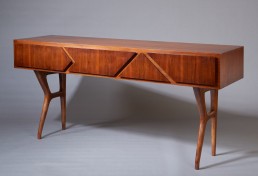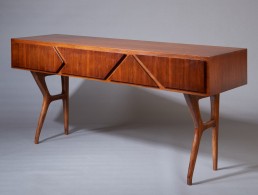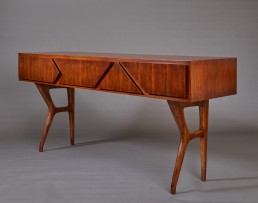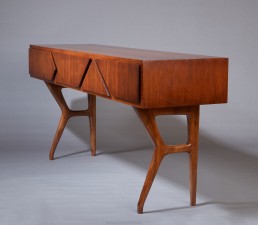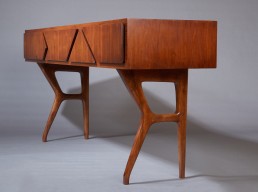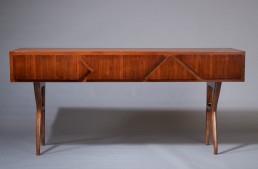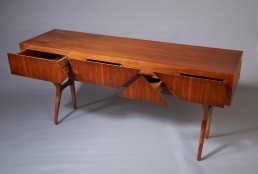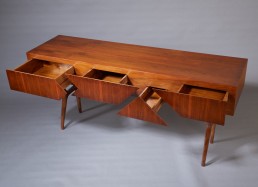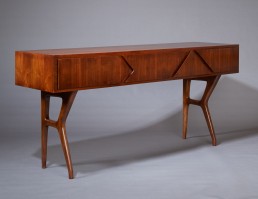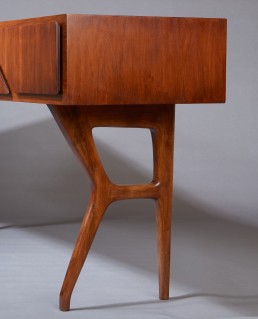Melchiorre Bega: Important Geometric Four Drawer Console in Walnut, Italy 1950s
Melchiorre Bega (1898-1976)
A large and important console by Bolognese architect and designer Melchiorre Bega, in polished walnut. The elongated rectangular top, enhanced by a beautiful tactile grain and precise craftsmanship, features four geometric cutout drawers, distinct interlocking polygons that flow into each other and project slightly from the surface. The body is raised on sculptural, tapering R-shaped legs with sinuous rounded openings.
For Bega the architect, the main preoccupations of contemporary engineering — “to create stronger and more daring structures” — extended to his furniture design. This spare, elegant buffet combines an understated rationalism with a purified organic style, creating angles that are at once arresting sculptural statements and cleanly functional — the polygons revealing drawers of different sizes to neatly accommodate a wide variety of items. Born into a family of designers and restorers outside Bologna, Bega was educated in the craftsmanship tradition of the family firm, Vittorio Bega & Figli, and went to work there full-time in 1919, after graduating from the Fine Arts Academy of Bologna. He started out restoring delicate furniture, before progressing to manufacture and design. This connection to craftsmanship remained a constant throughout his half-century career, which encompassed the creation of household products, furniture, private homes, retail shops, cafés and bars, hotels and movie theaters, banks and office high-rises, churches and schools, yachts and cruise ships. For most of these assignments, he also designed the furnishings and oversaw their manufacture.
Bega’s stripped down, unfussy design vocabulary captured the modern, accelerated pace of life in the post-war period, without ever sacrificing style. He understood that shopping or going to a bar or café was not merely a transaction, but an aesthetic, self-affirming experience. When clients entered a Bega space, they stepped into a gesamtkunstwerk. Depending on the job, Bega designed the display windows, the shelving, counters, fixtures, and furnishings, controlling the entire customer experience.
Bega applied that same attention to detail to the refined furniture he designed for the residences of private clients. Gio Ponti, who saw Bega as a creative visionary, promoted his work in Domus throughout the 1930’s. In 1941, Bega succeeded Ponti at the magazine’s helm, in turn promoting the work of avant-garde designers like Carlo Mollino, Marco Zanuso, and BBPR. In the 1950’s and 60’s, he went on to build some of Italy’s most important skyscrapers, including Milan’s famed Galfa Tower (opposite Ponti’s Pirelli Tower) and the Torre San Vincenzo in Genoa.
Bega arguably did as much as many better-known designers to put his stamp on the urban and domestic design world we inhabit today. With their focus on clean lines and use of space, his interiors of the ‘20s and ‘30s challenged and disturbed established bourgeois design traditions; his buildings of the ‘50s and ‘60s reimagined the skyline of Italian cities. His work includes over 300 projects in the major cities of Italy and abroad. In Milan and Bologna alone, Bega designed 40 retail stores, eight hotels, and 41 public buildings. His commissions abroad took him to Tripoli, Hamburg, Berlin, Paris, London, Geneva, Ankara and New York, where he oversaw the interior design of the Palazzo d’Italia in Rockefeller Center. Sadly, many of his most iconic interiors, especially the stores, bars, and cafés of the 1920’s and 1930’s, have been lost to the constant urban renewal of major cities. His skyscrapers — and rare furnishings like this console— however, remain, testaments to one of the most fertile, vibrant talents of the 20th century.
Italy, 1950’s.
- Origin: Italy
- Period: 1950's
- Dimensions: 78" L x 36" H x 21" D
- Materials: Polished walnut
- Condition: Very good restored condition; wear consistent with age and use.
Out of stock

